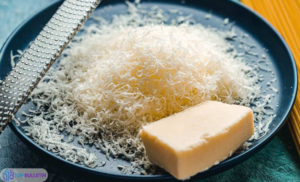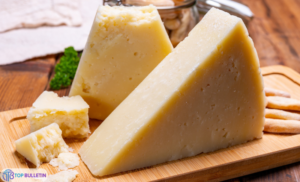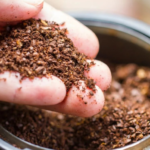When it comes to bold flavor and sharp tang, Romano cheese stands out as a beloved staple in kitchens around the world. Whether you’re grating it over pasta, mixing it into sauces, or simply snacking on slices, this hard cheese delivers a flavor punch that’s tough to forget.
For many food lovers and home cooks, questions like “What is Romano_cheese?”, “Is Romano_cheese Parmesan?”, and “What does Romano_cheese taste like?” often pop up when exploring cheeses beyond the basics. This guide will walk you through everything you need to know — from its rich history to how it compares to Pecorino Romano cheese, and even the best Romano_cheese substitutes when you’re in a pinch.
What Is Romano Cheese?
 Romano_cheese is a hard, salty cheese known for its robust flavor and granular texture. It’s traditionally made from cow, goat, or sheep’s milk and aged for several months to intensify its flavor. While often compared to Parmesan, Romano has a noticeably sharper and more pronounced taste, making it ideal for dishes that need a bold cheesy kick.
Romano_cheese is a hard, salty cheese known for its robust flavor and granular texture. It’s traditionally made from cow, goat, or sheep’s milk and aged for several months to intensify its flavor. While often compared to Parmesan, Romano has a noticeably sharper and more pronounced taste, making it ideal for dishes that need a bold cheesy kick.
There are different varieties of Romano, but the most famous type is Pecorino Romano_cheese, which is made from sheep’s milk and carries a salty, tangy punch. It’s a favorite in classic Italian recipes and often found grated over pasta and risottos.
Origin and History of Romano Cheese
The roots of Romano_cheese trace back over 2,000 years to ancient Rome. In fact, Pecorino Romano_cheese was a staple in the diet of Roman soldiers, appreciated for its long shelf life and intense flavor. The term “Romano” itself simply refers to the Roman region — not one specific cheese.
Today, authentic Pecorino Romano is produced primarily in Sardinia, Lazio, and Grosseto in Italy under strict PDO (Protected Designation of Origin) regulations. However, other forms of Romano_cheese, made from cow’s milk, are also produced in the U.S. and other parts of the world.
What Does Romano Cheese Taste Like?
Let’s break it down. If you’re asking, “What does Romano cheese taste like?” — the answer is salty, sharp, and slightly nutty. Its texture is dry and crumbly, and it can pack quite a punch, especially when made from sheep’s milk.
-
Pecorino Romano: Saltiest and strongest in flavor
-
Vaccino Romano (Cow’s milk): Milder and creamier
-
Caprino Romano (Goat’s milk): Tangy with earthy notes
Because of its assertive taste, Romano_cheese is usually used in small amounts — but it goes a long way in boosting the flavor of your dishes.
Romano Cheese vs. Parmesan: What’s the Difference?
It’s easy to confuse Romano_cheese with Parmesan, especially when both are grated over pasta. However, there are key differences between the two:
| Feature | Romano Cheese | Parmesan Cheese |
|---|---|---|
| Milk Used | Sheep, cow, or goat | Cow |
| Flavor | Sharp, salty, tangy | Nutty, milder, more complex |
| Texture | Crumbly and grainy | Firm and granular |
| Aging Time | ~5 to 8 months | ~12 to 36 months |
| Popular Use | Bold-flavored recipes | Smooth and savory dishes |
So, is Romano_cheese Parmesan? No, they’re distinct cheeses — though both are delicious in their own right.
Popular Uses of Romano Cheese
Thanks to its strong flavor, Romano_cheese is a hero ingredient in many Italian and Mediterranean dishes. Some favorite ways to use it include:
-
Grated over pasta: Especially on carbonara or amatriciana
-
In salad dressings: Adds umami depth to Caesar dressing
-
As a pizza topping: Mix with mozzarella for an intense cheesy layer
-
In meatballs or meatloaf: Enhances flavor in ground meat mixtures
-
Baked into breads: Think Romano_cheese garlic bread
Its versatility makes it a pantry essential for cheese lovers who enjoy bold, rich flavors.
Best Romano Cheese Substitutes
Sometimes you’re mid-recipe and realize you’re out of Romano_cheese. No worries — there are some great substitute for Romano_cheese options available:
-
Parmesan Cheese
Slightly milder, but a good 1:1 replacement in most dishes. -
Grana Padano
Aged and nutty, it works well for grating. -
Asiago
Less salty but still flavorful and great in baked dishes. -
Dry Jack (Aged Monterey Jack)
Crumbly texture and bold flavor make it a solid substitute. -
Cotija (Mexican cheese)
Use cautiously — it’s very salty and dry like Romano.
So, whether you’re making pasta or soup, you’ve got options.
How to Store Romano Cheese Properly
To maintain its flavor and shelf life:
-
Wrap it tightly in wax paper or cheese paper, then place in a resealable plastic bag.
-
Store in the refrigerator, ideally in a cheese drawer.
-
Avoid freezing unless grated — freezing may affect texture but is fine for long-term storage.
Proper storage keeps grated Pecorino Romano_cheese fresh and ready to use anytime.
Where to Buy Romano Cheese
Looking for Romano_cheese at the store? Here’s where you can check:
-
Supermarkets: Usually found near the Parmesan in the specialty cheese section.
-
Italian delis: Often carry imported Pecorino Romano cheese.
-
Online retailers: Gourmet cheese shops like Murray’s or iGourmet offer great selections.
Make sure to read the label — if you want authentic flavor, go for Pecorino Romano with the PDO stamp.
Is Romano Cheese Good for You?
 Romano cheese is packed with nutrients:
Romano cheese is packed with nutrients:
-
Protein-rich: Great for building muscle
-
Calcium-loaded: Supports bone health
-
Vitamins A & B12: Boost immunity and energy
However, it’s also high in sodium, so moderation is key — especially if you’re watching your salt intake.
Grated Pecorino Romano Cheese: Pantry Staple
Buying grated Pecorino Romano_cheese saves time in the kitchen. It’s perfect for tossing into:
-
Pasta dishes
-
Soup
-
Salad dressings
-
Scrambled eggs
-
Popcorn (yes, try it!)
Just store it well and you’ll always have a flavor boost on hand.
Bio Table
| Feature | Details |
|---|---|
| Cheese Type | Hard, aged |
| Milk Source | Sheep (Pecorino), cow, goat |
| Origin | Italy (Rome region) |
| Texture | Crumbly, granular |
| Taste Profile | Salty, tangy, bold |
| Common Form | Grated or block |
| Aging Period | 5 to 8 months |
| Popular Variety | Pecorino Romano |
| Culinary Uses | Pasta, salads, baking |
| Shelf Life | 4–6 weeks (refrigerated) |
| Substitutes | Parmesan, Asiago, Cotija |
| Health Benefits | Protein, calcium, vitamins |
Conclusion
In the world of cheese, Romano_cheese holds its ground as a strong, flavorful, and versatile ingredient. Whether you’re grating it over a bowl of spaghetti or mixing it into a creamy dressing, this cheese adds character and depth to every dish. From Pecorino Romano_cheese to cow’s milk variations, there’s a type and use for every palate.
And if you’re ever in need of a Romano_cheese substitute, you’re now well-equipped to make a smart choice. So next time you’re at the store or planning your dinner, don’t overlook this bold classic — it’s more than just a cheese; it’s a flavor experience.
FAQs
1.What is Romano cheese made from?
Cheesemakers craft Romano_cheese using milk from cows, goats, or sheep. They use only sheep’s milk to create Pecorino Romano, the most popular variety.
2. What does Romano cheese taste like?
It has a salty, tangy, and sharp flavor that’s stronger than Parmesan. It also has a crumbly, dry texture.
3. Can I use Parmesan as a Romano_cheese substitute?
Yes, Parmesan is a milder but excellent 1:1 substitute in most recipes where Romano_cheese is used.
4. How long does Romano_cheese last?
When properly stored in the refrigerator, Romano_cheese can last up to 6 weeks. Grated versions may last slightly less.
5. Is Pecorino Romano cheese the same as Romano cheese?
Pecorino Romano comes from sheep’s milk and delivers the strongest, saltiest flavor among all Romano cheese varieties.






